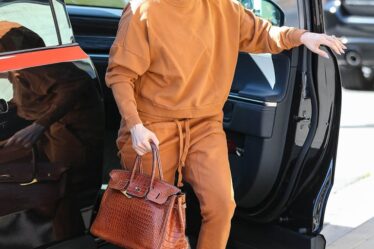
Watch the full interview, Building a Career in Fashion with Ssense’s Haein Dorin, on-demand on LinkedIn. Discover similar job opportunities across the globe on BoF Careers today.
Haein Dorin’s first foray into fashion was on the shopfloor at Abercrombie & Fitch as a teenager ahead of attending the University of Southern California. She went on to work in entertainment publicity, collecting internships and work placement roles at the likes of Warner Brothers, Sony Pictures and NBC Universal, before landing a temp job at publishing house Condé Nast.
It was here that Dorin turned a temporary position into her first full-time job, going from “picking up dry cleaning to pulling reporting for how corporate deals were being transacted.” She credits her “willingness to learn and roll up [her] sleeves” with impressing her seniors at Condé Nast, who offered her a job in corporate partnerships.
From there, Dorin went on to work at the likes of GQ as director of brand marketing before moving to Highsnobiety in 2019, where she rose up the ranks to become general manager of client services. In 2023, Dorin joined fashion e-commerce platform Ssense as global head of partnerships and community, where she oversees global brand partnerships within the creative, fashion and business communities.
Now, BoF shares key insights and advice from Haein Dorin’s interview on the BoF Careers series, Building a Career in Fashion.
What drew you to working in the fashion industry?
I have been working for as long as I can remember. I come from a financially challenged background and so I played a part in contributing financially for my family wherever I could [while] growing up. My first official job was in retail when I was 16 at Abercrombie & Fitch — it was an amazing job. I learned the fundamentals of retail and came to understand the stock room — starting off from the ground there.
I was so fascinated because, as you know, season after season, you’d be getting these products and seeing which products sold the fastest, the popularity that it gained and how that influenced culture. I think that’s definitely when I started to dream about working in this industry.
What role has further education played in advancing your career?
University was such an enriching and challenging time for me because I wasn’t quite sure of the career I wanted to go into. A lot of my classes were in observational studies — in the arts — I did international relations, art history, media studies. I fell in love with the world of media and entertainment during that time. That’s what I found the most interesting and it pushed my critical thinking.
I was attending a lot of career fairs, talking to a lot of my teachers. During that time, I landed my first internships, which were in publicity, which [happened] completely out of luck because I had applied to hundreds of internships seeing where I could gain the most experience.
Coming from an immigrant family, I was the first person to have corporate experience. It was an invaluable jumpstart to my career, learning the fundamentals, like how to write an email properly. I learnt how to structure storytelling pitches and create experiences for different audiences, for different films. That experience helped me build that skillset of corporate communications and how to position stories, which really prompted my interest in going into the media world.
How did you land your first full-time role in fashion?
I dabbled in a lot of different industries — PR, comms, media. I was an admin assistant temp before I was a finance temp at Riot Games. At my last temp role in events at Condé Nast, I was lucky enough [to meet] two amazing mentors who offered me a full-time job, which was how I broke into the fashion industry as a digital associate on the corporate partnerships team.
These women saw something in me that I didn’t. I went from picking up dry cleaning to pulling reporting for how these corporate deals were being transacted. And so, there were a lot of late nights, a lot of tears and overnighters at the office of me learning the skill set.
Across industries, a lot of the foundations of what you do day-to-day is very similar, whether you are writing to somebody about a pitch or an idea, or you are in meetings […] communicating with the leadership team.
Your first job might not be exactly what you’re dreaming of or what you aspired to do, but the skill sets that I learned in terms of billing, reconciliation, learning how to read an analytics report and pull insights out of that — those are still skills that I [still] use today. No matter what the job is, it’s in front of you. Just try to learn it and become well-versed in it, because that is just another skill set that’s going to help you get your next job.
How did you hone your skill sets for the fashion workplace?
When I broke into fashion, I had a publicity, PR and communications background. At the time, fashion was all about digital marketing and a lot of that is based on storytelling. So, bringing that communications background was helpful because I was able to position a pitch email and [use] my skill set in terms of writing that email which could be translated into a business opportunity.
Across industries, a lot of the foundations of what you do day-to-day is very similar, whether you are writing to somebody about a pitch or an idea, or you are in meetings and you are effectively communicating upwards to your leadership team or your team. A lot of that is about how you are communicating in the workplace.
My current mentor, who was my manager, always said: “How can you show up today and tomorrow and be able to contribute and rally the teams and propose solutions to move it forward?” And it is exactly that mentality — how do you show up everyday with a blank slate and really try to dive in and problem solve?
How would you recommend building your network when starting out?
Today, more than ever, with platforms like LinkedIn, TikTok, Instagram, everyone is starting to tell their transparent stories. It’s amazing to be able to have direct communication with people in the industry. So many of my mentors and industry leaders now, I first became friends with on social media. We started following each other on social then we got to work on projects together. We would go to an event together and further deepen that relationship.
I would [suggest you] reach out to whoever you would love to learn from. Sometimes they might not respond, but I think that most of the time they will and they are always willing to help because everyone started their career in some capacity by receiving mentorship and growing their community.
It’s kind of like dating — there are going to be some people in the workplace that you meet [with whom] you immediately click and bond. And then there are some people in the workplace where you will grow to learn to respect each other because of the work that you do. For me — it was really a matter of relatability. I grew up an only child and so I was always seeking that bond of friendship and community.
How did you develop leadership skills to progress in your career?
My first promotion into a leadership position was at that first job [at Condé Nast] […] leading all the digital planning out of the West Coast. As a leader, you have to be outward facing internally, to build relationships with different departments. That way, you are able to get information [you need] ahead of time around what sponsorships are happening, which sets you and the team up for success in terms of knowing the work that needs to be done.
Your first job might not be exactly what you’re dreaming of or what you aspired to do, but the skill sets that I learned in my first job […] are still skills that I use today.
I was able to see that it’s actually not just about my job and my team — it’s about how I liaise with the other departments to be able to set my team up for success. So that type of role opened lots of other possibilities that led to me transitioning into a role at GQ.
As a leader, there’s nothing more important than understanding and hearing what has been going on. What has been working? What hasn’t been working? With your leadership methodologies, it is crucial to understand this from a human and empathetic point of view. Then, you can build and adjust or make small tweaks here and there, in order to make things more efficient or innovate some type of department capability.
But it all goes back to being observational and learning before having two feet on the ground and starting to run.
What does your job entail as global head of partnerships and community at Ssense?
I’ve been at Ssense for about four months now — and it’s a 20-year-old successful e-commerce and content, cultural hub. It’s […] learning about the audience and listening to what our community wants, building a partnership strategy around that. I’ve been working hand-in-hand with our insights and customer analytics team to figure out [what that looks like].
My job really is to observe, see what is doing well and what the community likes, and ask the questions: “What does the Ssense universe look like? Who are our shoppers and readers? What are they eating? How are they decorating their homes? What would they want to drive?” Building that community and the world around it.
It’s incredibly varied: I’m analysing customer data one day; another day I’m crafting an F1 programme with a partner; the next day, we are integrating a beauty brand into the editorial calendar. Everything is about taking what already exists and bringing brands into the magic that is already being done.
What do you value in a junior today?
I love people that are showing their willingness to learn new things every day, because that’s also my interest. After a decade of experience, I’m back in school, learning about business and marketing, and it’s nice because it’s almost like having a tutor for my workplace, which is super helpful.
What I love is if there is a skill set that you haven’t developed yet, but you’re willing to take those extra hours, [you can] take that extra online course to learn it. That always stands out to me because it shows me, if we have another business challenge that we face in another year, I know I’m building a team of individuals that want to come on board, who are open to learning skills that they don’t know yet in order to contribute and push the business goals further.



